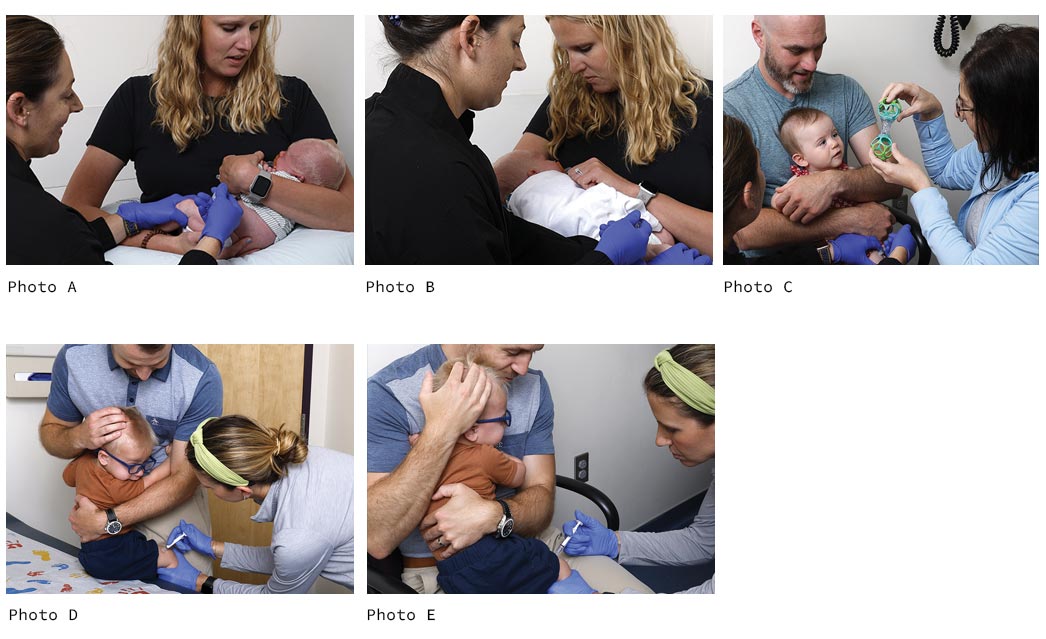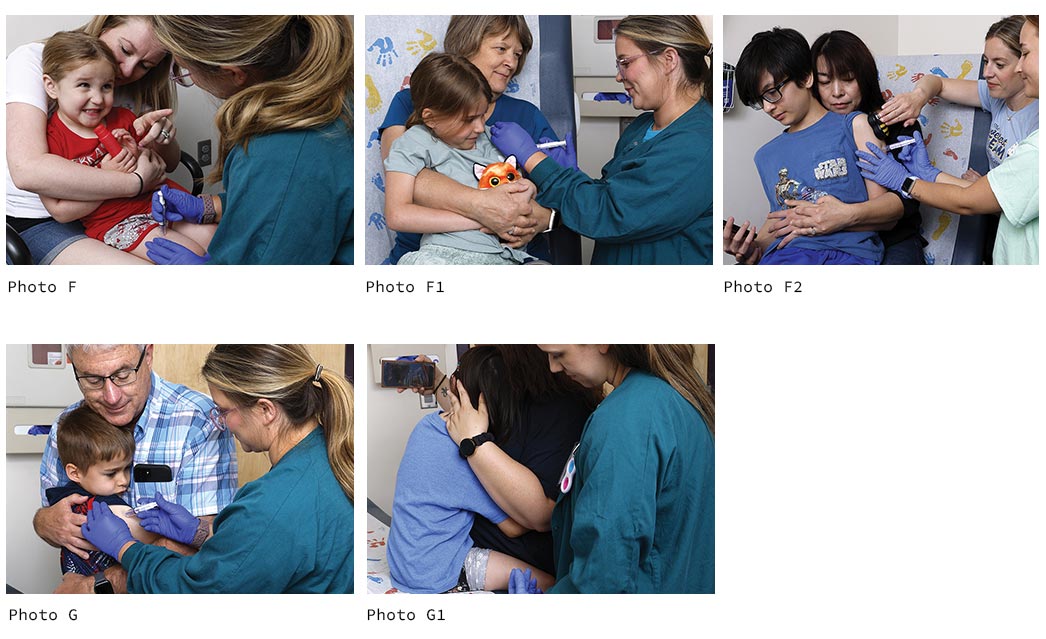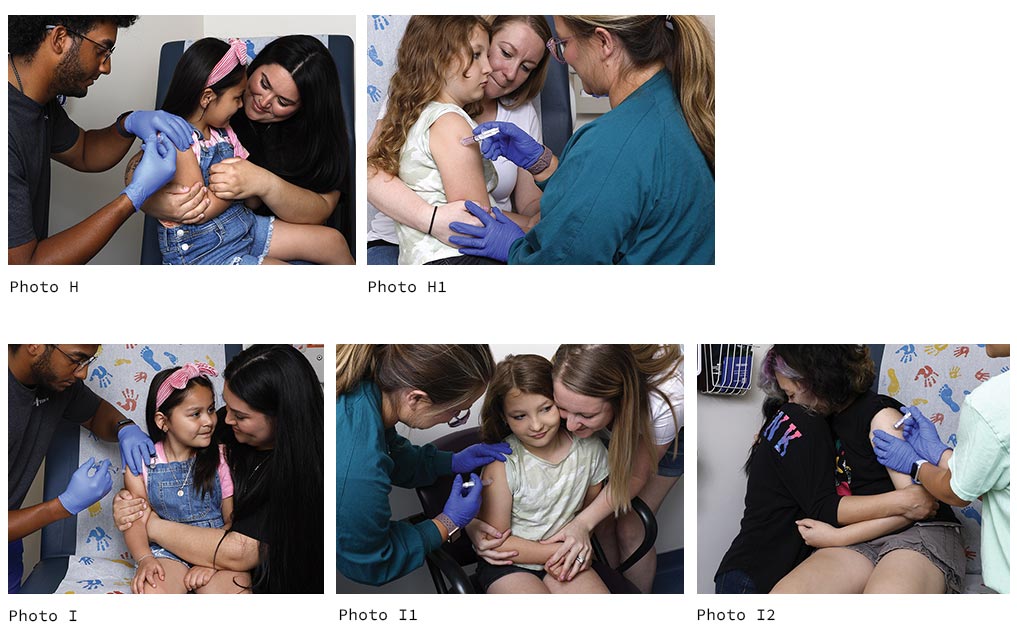Comfort Positions for Your Child
As hard as you try, it can be difficult to reassure a child that the doctor's office isn't something to be afraid of. At Boys Town National Research Hospital and Clinics, we want to help provide an emotionally safe experience for your child and for you. Whether it's a simple examination, a vaccine or another procedure, these comfort positions can help calm and reassure children and teens.
Comfort Positions for Newborns, Infants and Toddlers (Ages 0 to 24 Months)
Little ones are often easier to contain during moments of tension or stress. It's important to talk calmly to your child during the hold and procedure. Pacifiers have been studied and recommended for pain relief for infants having minor procedures like vaccinations. Many doctors' offices also have a sucrose (sugar) solution available that address additional pain relief for infants, so please feel free to ask.
Different comfort positions for newborns and infants (ages 0-6 months) include:
- Cradle (Photo A)
- While your child is lying flat in your arms, cuddle them close to you
- Leave your child's leg out for the injection
- Snuggle your child's other leg and arms close to your body
- Swaddle (Photo B)
- Have your child swaddled in a blanket but leave one leg out for the injection
- Snuggle your arm around your child and hug their body close to your chest
Comfort positions for infants and toddlers (ages 6 to 24 months) include:
- Back-to-Chest (Photo C)
- Wrap your arms around your child and hold their hands and arms with yours and try to keep their back and bottom pressed firmly next to you
- If the patient is receiving a leg vaccine, use your legs to “scissor" your child's legs to help hold them still
- Hug your child firmly and sometimes it's even possible to hold a phone with a video for distraction
- Chest-to-Chest for older ages (Photo D)
- Tuck your child's arms into their chest
- Straddle their legs around your hips
- Ensure your child cannot kick anything behind you
- Hug your child firmly and offer distraction on the opposite side of the injection
- Side-sit (Photo E)
- Tuck your child's arms in front of them and hold them against their chest
- Use your legs to “scissor" your child's legs or a nurse or provider can lean against your child's legs to prevent kicking
- Hold your child firmly and, if possible, hold a phone with a video for distraction

Comfort Positions for Children (Ages 2 to 8 Years)
Children may receive injections in either their arm or leg. Boys Town Child Life recommends the same holds for either injection, with some minor modifications to account for the injection site or your child's size.
- Back-to-Chest (Photo F, F1, F2)
- Hold hands and arms of child in tight hug with your arms and hands
- For leg injection, use your leg to wrap around the child's legs to help prevent movement
- Hug your child firmly and offer some form of distraction when possible
- Chest-to-Chest (G, G1)
- Tuck your child's arms in front of them and hold them against their chest
- Have your child's legs straddled around your hips
- Ensure your child cannot kick up against objects behind you
- Hug your child firmly and offer some form of distraction when possible
- Side-sit (Photo H, H1)
- Child sits sideways on your lap, either in a chair or on exam table
- Tuck your child's arms in front of them and hold them against their chest
- Use your legs to “scissor" your child's legs or a nurse or providers can lean against your child's legs to prevent kicking
- Hold your child firmly and offer some form of distraction when possible
- Side-hug (Photo I, I1, I2)
- Sit next to your child and wrap one arm around them behind their back
- Use the arm wrapped around them to help secure their arm receiving the injection
- Use your free hand to hold their second arm close to their body and out of the way
- If your child is getting the injection in their leg, you can use both arms to give a supportive hug and even hold their hands


Comfort Positions for Older Children (Ages 9 to 12 Years)
Older children most often receive injections in their arm, however sometimes a leg is chosen. Boys Town Child Life recommends the same holds for either injection, with some minor modifications to account for the injection site or your child's size.
- Back-to-Chest (Photo F, F1, F2)
- Your child can sit, leaning up against you for support
- Hold hands and arms of child in tight hug with your arms and hands, providing support as needed
- For leg injections, use your leg to wrap around the lower half of your child's legs to help prevent movement
- Hug your child firmly and offer some form of distraction if needed
- Chest-to-Chest when exam table is nearby (G, G1)
- Tuck your child's arms in front of them and hold them against their chest
- Have your child's legs straddled around your hips
- Ensure your child cannot kick up against objects behind you
- Hug your child firmly and offer some form of distraction when possible
- A nurse or provider can lean against your child's legs to prevent kicking if needed
- Side-sit (Photo H, H1)
- Younger children may want to sit sideways on your lap, either in a chair or on exam table
- Tuck your child's arms in front of them and hold them against their chest
- A nurse or provider can lean against your child's legs to prevent movement
- Hold your child firmly and offer some form of distraction when possible
- Side-hug (Photo I, I1, I2)
- Sit next to your child and wrap one arm around them behind their back
- Use the arm wrapped around them to help secure their arm receiving the injection
- Use your free hand to hold their second arm close to their body and out of the way
- If your child is getting the injection in their leg, you can use both arms to give a supportive hug and even hold their hands


Comfort Positions for Teenagers (Ages 13+ Years)
There are lots of teenagers who also experience anxiety with needle procedures and that's okay, we're here to support you.
- Back-to-Chest (Photo F, F1, F2)
- Your teen may find comfort sitting and leaning up against you for support
- Hold hands and arms of your teen in tight hug with your arms and hands, providing support as needed
- Hug your child firmly and use distraction or guide them in taking slow, deep breaths
- Side-sit (Photo H, H1)
- Your teen may find comfort with you sitting beside them on an exam table with your arm wrapped around them
- Have your teen tuck their free arm in front of them and help them hold it against their chest
- Hold your child firmly if needed and offer some form of distraction or guide them in taking slow, deep breaths
- Side-hug (Photo I, I1, I2)
- Stand next to your teen and wrap one arm around them behind their back
- Use the arm wrapped around them to help secure their arm receiving the injection
- Some teens prefer to lean into their caregiver in a hug position for support
- Use your free hand to hold their second arm close to their body and out of the way


Immunizations;Health and Safety
Pediatrics
